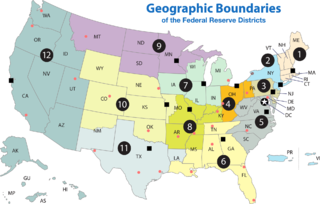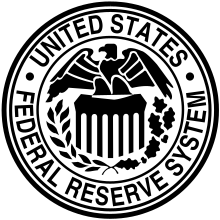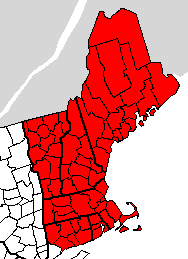
The Federal Reserve System is the central banking system of the United States. It was created on December 23, 1913, with the enactment of the Federal Reserve Act, after a series of financial panics led to the desire for central control of the monetary system in order to alleviate financial crises. Over the years, events such as the Great Depression in the 1930s and the Great Recession during the 2000s have led to the expansion of the roles and responsibilities of the Federal Reserve System.

The Federal Reserve Act was passed by the 63rd United States Congress and signed into law by President Woodrow Wilson on December 23, 1913. The law created the Federal Reserve System, the central banking system of the United States.

A Federal Reserve Bank is a regional bank of the Federal Reserve System, the central banking system of the United States. There are twelve in total, one for each of the twelve Federal Reserve Districts that were created by the Federal Reserve Act of 1913. The banks are jointly responsible for implementing the monetary policy set forth by the Federal Open Market Committee, and are divided as follows:

The chairman of the Board of Governors of the Federal Reserve System is the head of the Federal Reserve, and is the active executive officer of the Board of Governors of the Federal Reserve System. The chairman presides at meetings of the Board.
The Federal Open Market Committee (FOMC) is a committee within the Federal Reserve System that is charged under United States law with overseeing the nation's open market operations. This Federal Reserve committee makes key decisions about interest rates and the growth of the United States money supply. Under the terms of the original Federal Reserve Act, each of the Federal Reserve banks was authorized to buy and sell in the open market bonds and short term obligations of the United States Government, bank acceptances, cable transfers, and bills of exchange. Hence, the reserve banks were at times bidding against each other in the open market. In 1922, an informal committee was established to execute purchases and sales. The Banking Act of 1933 formed an official FOMC.

The Federal Reserve Bank Building is the sixth tallest building in Boston, Massachusetts. It is located at Dewey Square, on the convergence of Fort Point and the Financial District neighborhoods. In close proximity to the Boston Harbor, the Fort Point Channel and major intermodal South Station terminal, the building is marked by a distinctive opening near ground level which allows sea breezes to pass through.
This history of central banking in the United States encompasses various bank regulations, from early wildcat banking practices through the present Federal Reserve System.

The Federal Reserve Bank of San Francisco is the federal bank for the twelfth district in the United States. The twelfth district is made up of nine western states—Alaska, Arizona, California, Hawaii, Idaho, Nevada, Oregon, Utah, and Washington—plus the Northern Mariana Islands, American Samoa, and Guam. The San Francisco Fed has branch offices in Los Angeles, Portland, Salt Lake City, and Seattle. It also has a cash processing center in Phoenix.

The Board of Governors of the Federal Reserve System, commonly known as the Federal Reserve Board, is the main governing body of the Federal Reserve System. It is charged with overseeing the Federal Reserve Banks and with helping implement the monetary policy of the United States. Governors are appointed by the president of the United States and confirmed by the Senate for staggered 14-year terms. It is headquartered in the Eccles Building on Constitution Avenue, N.W. in Washington, D.C.

The Federal Reserve Bank of Kansas City is located in Kansas City, Missouri and covers the 10th District of the Federal Reserve, which includes Colorado, Kansas, Nebraska, Oklahoma, Wyoming, and portions of western Missouri and northern New Mexico. It is second only to the Federal Reserve Bank of San Francisco in size of geographic area served. Missouri is the only state with two main Federal Reserve Banks; the other is located in St. Louis.

The Federal Reserve Bank of St. Louis is one of 12 regional Reserve Banks that, along with the Board of Governors in Washington, D.C., make up the United States' central bank. Missouri is the only state to have two main Federal Reserve Banks.

The Federal Reserve Bank of Dallas covers the Eleventh Federal Reserve District of the United States, which includes Texas, northern Louisiana and southern New Mexico, a district sometimes referred to as the Oil Patch. The Federal Reserve Bank of Dallas is one of 12 regional Reserve Banks that, along with the Board of Governors in Washington, D.C., make up the U.S. central bank. The Dallas Fed is the only one where all external branches reside in the same state . The Dallas Fed has branch offices in El Paso, Houston, and San Antonio. The Dallas bank is located at 2200 Pearl St. in the Uptown neighborhood of Oak Lawn, just north of downtown Dallas and the Dallas Arts District. Prior to 1992, the bank was located at 400 S. Akard Street, in the Government District in Downtown Dallas. The older Dallas Fed building, which opened in 1921, was built in the Beaux-arts style, with large limestone structure with massive carved eagles and additional significant detailing; it is a City of Dallas Designated Landmark structure. The current Dallas Fed building, opened in September 1992, was designed by three architectural firms: Kohn Pedersen Fox Associates, New York; Sikes Jennings Kelly & Brewer, Houston; and John S. Chase, FAIA, Dallas and Houston, Dallas-based Austin Commercial Inc. served as project manager and general contractor.

The Federal Reserve Bank of Chicago is one of twelve Federal Reserve Banks that, along with the Federal Reserve Board of Governors, make up the Federal Reserve System, the United States' central bank. The Chicago Fed serves the Seventh District, which encompasses the northern portions of Illinois and Indiana, southern Wisconsin, the Lower Peninsula of Michigan, and the state of Iowa. In addition to participation in the formulation of monetary policy, each Reserve Bank supervises member banks and bank holding companies, provides financial services to depository institutions and the U.S. government, and monitors economic conditions in its District.

The Federal Reserve Bank of Atlanta,, is the sixth district of the 12 Federal Reserve Banks of the United States and is headquartered in midtown Atlanta, Georgia.

Cathy E. Minehan was President and Chief Executive Officer of the Federal Reserve Bank of Boston from 1994 until her retirement in July 2007. Minehan also served as a member of the Federal Open Market Committee, the body responsible for U.S. monetary policy. She was "appointed Dean of the School of Management of Simmons College, a private university, in August 2011 and is Managing Director of Arlington Advisory Partners, a private advisory services firm."

Eric S. Rosengren took office on July 20, 2007, as the thirteenth president and chief executive officer of the Federal Reserve Bank of Boston, serving the First District. As a Fed president, he was a participant and voting member of the Federal Open Market Committee. He retired on September 30, 2021.
The Federal Reserve Bank of Cleveland Pittsburgh Branch Office is one of two Federal Reserve Bank of Cleveland branch offices. The Pittsburgh Office of the Federal Reserve Bank of Cleveland hosts one of two savings bonds processing sites in the nation. The Pittsburgh branch presides over Jefferson, Monroe and Belmont counties in Ohio, Wetzel, Tyler, Pleasants, Marshall, Ohio, Brooke and Hancock counties in West Virginia, and all of Western Pennsylvania. In 1915 it was revealed that the Pittsburgh branch location was to be the new home of a relocated Cleveland Fed District with a majority vote secured on the board of governors, but the U.S. Attorney General at the time nixed moving the Cleveland, Kansas City, Minneapolis, Boston and Atlanta Federal Reserve Districts, stating that it would instead take an act of Congress to move those district headquarters. Pittsburgh remained a branch location only.

The Federal Reserve Bank of Richmond Baltimore Branch Office is one of the two Federal Reserve Bank of Richmond branch offices. The Federal Reserve Bank of Richmond's Baltimore Branch is an operational and regional center for Maryland, the metropolitan Washington D.C. area, Northern Virginia, and northeastern West Virginia. The Baltimore branch is part of the Fifth District and has the code E5. It supports Check 21 operations, supplies coin and currency to financial institutions and works to maintain stability in the financial sector throughout the Fifth District and also works with local elected officials and non-profit organizations to support fair housing initiatives throughout the Fifth District. The Baltimore branch was founded in March 1918 and is currently headed by William R. Roberts.

The Structure of the Federal Reserve System is unique among central banks in the world, with both public and private aspects. It is described as "independent within the government" rather than "independent of government".

The vice chair of the Board of Governors of the Federal Reserve System is the second-highest officer of the Federal Reserve, after the chair of the Federal Reserve. In the absence of the chair, the vice chair presides over the meetings Board of Governors of the Federal Reserve System.






















